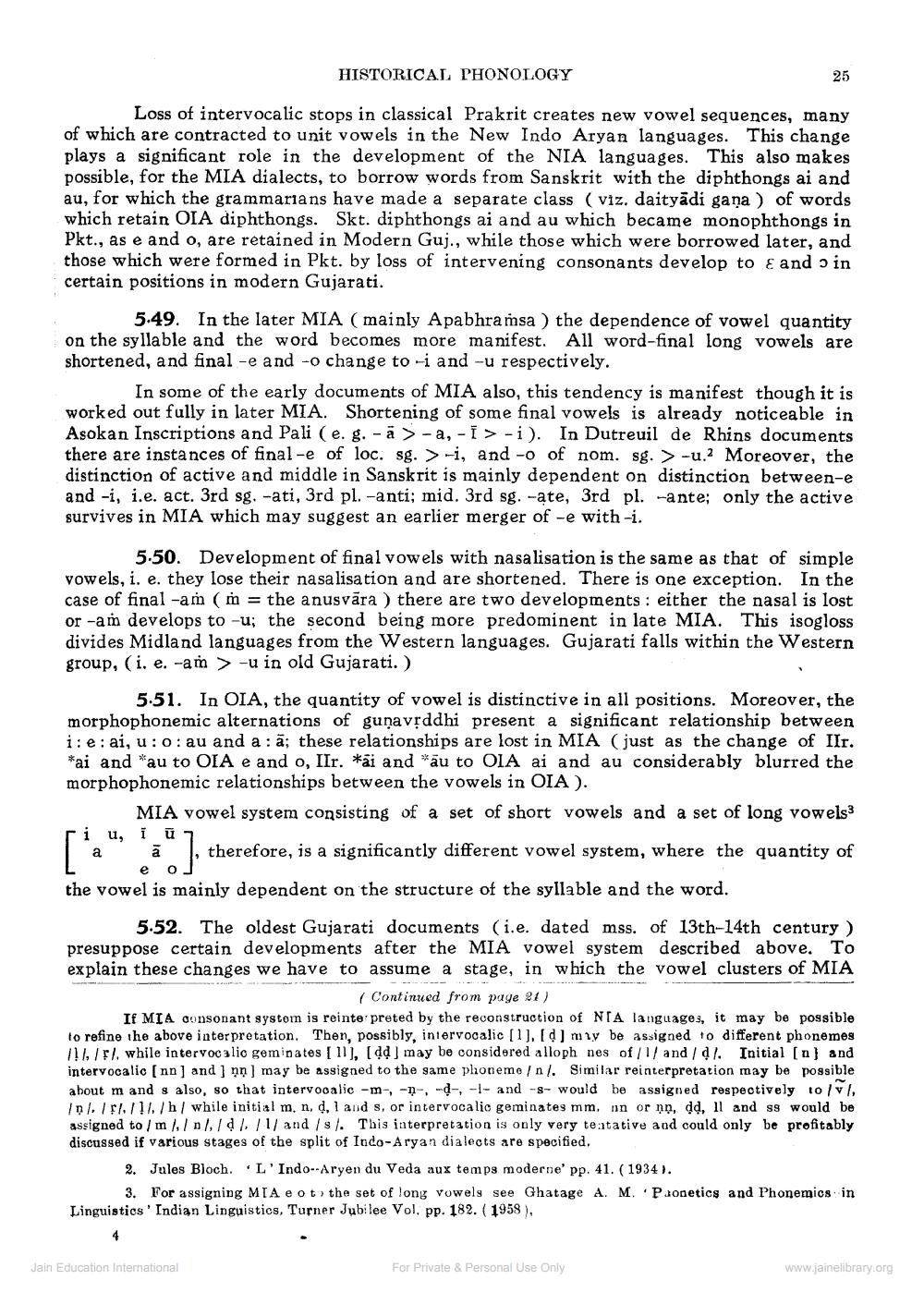________________
HISTORICAL PHONOLOGY
25
Loss of intervocalic stops in classical Prakrit creates new vowel sequences, many of which are contracted to unit vowels in the New Indo Aryan languages. This change plays a significant role in the development of the NIA languages. This also makes possible, for the MIA dialects, to borrow words from Sanskrit with the diphthongs ai and au, for which the grammarians have made a separate class (viz. daityādi gana ) of words which retain OIA diphthongs. Skt. diphthongs ai and au which became monophthongs in Pkt., as e and o, are retained in Modern Guj., while those which were borrowed later, and those which were formed in Pkt. by loss of intervening consonants develop to E and 5 in certain positions in modern Gujarati.
5:49. In the later MIA (mainly Apabhramsa ) the dependence of vowel quantity on the syllable and the word becomes more manifest. All word-final long vowels are shortened, and final -e and -o change to -i and -u respectively.
In some of the early documents of MIA also, this tendency is manifest though it is worked out fully in later MIA. Shortening of some final vowels is already noticeable in Asokan Inscriptions and Pali (e. g. - a> -a, -ī>-i). In Dutreuil de Rhins documents there are instances of final-e of loc. sg. > -i, and -o of nom. sg. > -u. Moreover, the distinction of active and middle in Sanskrit is mainly dependent on distinction between-e and -i, i.e. act. 3rd sg. -ati, 3rd pl. -anti; mid. 3rd sg. -ate, 3rd pl. -ante; only the active survives in MIA which may suggest an earlier merger of -e with-i.
5.50. Development of final vowels with nasalisation is the same as that of simple vowels, i. e. they lose their nasalisation and are shortened. There is one exception. In the case of final -am m = the anusvāra ) there are two developments: either the nasal is lost or -an develops to -u; the second being more predominent in late MIA. This isogloss divides Midland languages from the Western languages. Gujarati falls within the Western group, (i. e. -am > -u in old Gujarati.)
5.51. In OIA, the quantity of vowel is distinctive in all positions. Moreover, the morphophonemic alternations of guņavrddhi present a significant relationship between i:e: ai, u: o: au and a:ā; these relationships are lost in MIA (just as the change of IIr. *ai and *au to OIA e and o, IIr. *ai and *āu to OIA ai and au considerably blurred the morphophonemic relationships between the vowels in OIA).
MIA vowel system consisting of a set of short vowels and a set of long vowels3 ri u, i ն յ a ā , therefore, is a significantly different vowel system, where the quantity of
e od the vowel is mainly dependent on the structure of the syllable and the word.
5.52. The oldest Gujarati documents (i.e. dated mss. of 13th-14th century ) presuppose certain developments after the MIA vowel system described above. To explain these changes we have to assume a stage, in which the vowel clusters of MIA
(Continued from page 91) If MIA consonant system is reinte preted by the reconstruction of NTA languages, it may be possible to refine the above interpretation. Then, possibly, intervocalic [1]. (d) m y be assigned to different phonemes 11/, /fl, while intervoca lic geminates [11], (ad ) may be considered alloph nes of /l/ and / d l. Initial [n) and intervocalic (nn) and ] ņn) may be assigned to the same plaoneme/nl. Similar reinterpretation may be possible about m and s also, so that intervooalic -m -n-, --, -1- and -s- would be assigned respectively to/vl, in/.//./1/./h/ while initial m, n, d, 1 and s, or intervocalic geminates mm. on or nn, dd, ll and se would be assigned to / ml./n/, /d/, /1/ and / s). This interpretation is only very te:tative and could only be profitably discussed if various stages of the split of Indo-Aryan dialects are specified.
2. Jules Bloch. L'Indo-Aryen du Veda aux temps moderne' pp. 41. (1934).
3. For assigning MIA e ot the set of long vowels see Ghatage A. M. Paonetics and Phonemics in Linguistics' Indian Linguistics, Turner Jubilee Vol, pp. 182. (1958).
Jain Education International
For Private & Personal Use Only
www.jainelibrary.org




